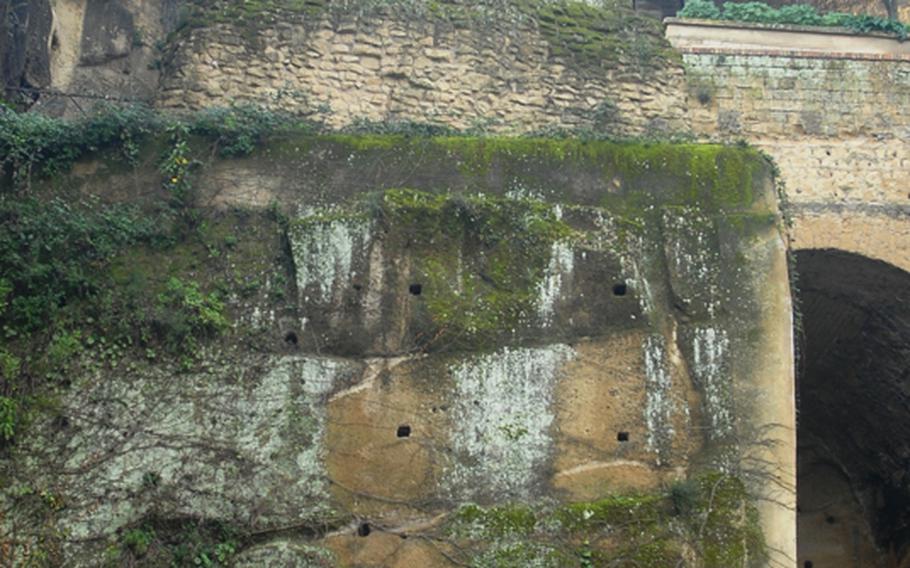
In Parco Vergiliano a Piedigrotta in Naples, Italy, rests a piece of typical Roman architecture that is purportedly the tomb of Virgil, the famed poet, philosopher and rumored sorcerer who lived between 70 and 19 B.C. Virgil died in Brindisi, about 230 miles from his beloved Naples. His remains were brought to Naples; though it's not known where for sure. The park, created in 1930 to celebrate the 2,000th anniversary of Virgil's birth, is where scholars best guess he might have been buried. (Sandra Jontz/Stars and Stripes)
For all the woes that blight the southern Italian seaside city of Naples, there are gems that can be charming.
Welcome to a quick tour of two city highlights — Virgil style.
In a small public park in the Mergellina neighborhood of Naples and perched atop a modest hill that offers an enchanting view, a tomb purports to be that of the famed Roman poet Virgil.
Yes, the same Virgil who accompanies Dante Alighieri during his traipse through hell. The very sage who predicted the rise of the Roman Empire in his poems and who — legend has it — placed an enchanted egg in a casket beneath Castel dell’Ovo.
Parco Vergiliano a Piedigrotta was created in 1930 to celebrate the 2,000th anniversary of Virgil’s birth, and is the site where scholars best guess he might be buried after he died in Brindisi in 19 B.C. and had his remains returned to his beloved Naples, according to several informational placards found throughout the park.
The unassuming park, easily missed if you’re not looking, sits behind the magnificent gray-and-cream church of Santa Maria di Piedigrotta, across from the Mergellina metro station. The park is tucked to the left before entering the Quatro Giornate tunnel that connects Mergellina to the Fuorigrotta neighborhood.
Meandering along the stone path, visitors can glimpse manicured lawns and vegetation meticulously selected from the flora, such as strawberries, myrtle and ivy, mentioned in Virgil’s works.
Also known as the park of the poets — though only two are buried there (and it’s doubtful that it’s the actual site of Virgil’s remains) — it draws pilgrims who pay homage to celebrated Italian poet Giacomo Leopardi, who died June 14, 1837, when a cholera epidemic struck the city.
Leopardi’s close friend Antonio Ranieri persuaded authorities to refrain from dumping Leopardi’s remains in a communal grave. Instead, Leopardi was buried in the atrium of the San Vitale church in Fuorigrotta. His tomb was moved to Parco Vergiliano a Piedigrotta in 1939, and was dedicated as a national monument, according to park information.
Before arriving at a tall stone wall where Virgil’s tomb purportedly sits, visitors come across the Crypta Neapoletana, or Grotta Vecchia (old cave), dug by the Romans in the first century B.C. to connect Naples to the seaside fishing town of Pozzuoli. Today, it is closed off to tourists due to landslides in the 1920s that made it dangerous.
Up one set of stairs, to the right of an overlook point that offers an inspirational view of Naples, and down another set of stairs sits the famed Roman columbarium that is supposedly Virgil’s tomb.
Inside the dank mausoleum sits a tripod burner into which tourists have left messages to the famed poet. One pilgrim, seeking inspiration, wrote: Che il tuo sommo spirit mi sta vicino nello studio delle tue parole. (“May your high spirit be near me in the study of your words.”)
The park is not the only link in Naples to Virgil. Roughly a 30-minute, very leisurely walk along Naples’ waterfront brings visitors to Castel dell’Ovo, or Egg Castle, the oldest of the many castles that dot Naples’ city grid.
It stands on the former tiny rocky island of Megaride in the Tyrrhenian Sea, and once was totally cut off by water. Today a bridge links the castle and other buildings — such as restaurants and apartments — to the mainland.
The name of Egg Castle is linked to the Virgilian legend that he placed an “enchanted” egg in a casket, buried it beneath the fortress, and proclaimed that should the egg ever break, Naples would endure calamities like never seen before.
Others believe it refers to the island’s oval shape.
But where’s the fantasy in that?
Directions Riding metro is best — take it to the Mergellina station. Walk toward the waterfront, hang a right at the traffic light, and then turn left just past the public parking facility and before entering the tunnel. It looks sketchy, but is worth it. To get to Castel dell’Ovo: From the park, turn right at the church of Santa Maria di Piedigrotta, head toward Mergellina harbor. At the harbor, turn left and walk along the waterfront to the castle. You can’t miss it.
Times Parco Vergiliano a Piedigrotta is open daily 9 a.m. to 6 p.m.; Castel dell’Ovo open Monday-Saturday 8 a.m. to 6 p.m., Sunday 8 a.m.-2 p.m.
Costs Both are free.
Food Save your appetite for a visit to the castle grounds, where one can’t lob a heavy stone without hitting a restaurant or cafe. Most of the restaurants in the area, both surrounding the castle and those that line the main pedestrian road on the mainland, serve predominantly seafood-based dishes, but there are pizzerias as well.